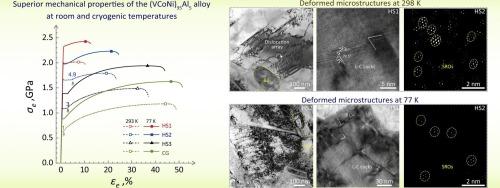Constructing multi-level heterogeneous structures in multi-principal element alloys for superior cryogenic tensile properties
IF 7.9
2区 材料科学
Q1 MATERIALS SCIENCE, MULTIDISCIPLINARY
引用次数: 0
Abstract
The multi-level heterogeneous structures, consisting of heterogeneous grain structure, B2 nanoprecipitates, and chemical short-range ordering (CSROs), were designed and fabricated in the (CoNiV)95Al5 multi-principal element alloy. The material exhibits superior tensile properties at 298 K, with simultaneous enhancement of yield strength and uniform elongation at 77 K. Specifically, it achieves ∼1.65 GPa yield strength and ∼19 % uniform elongation at room temperature, improving to ∼2.0 GPa and 22 % under cryogenic conditions (77 K). Under identical tensile strain, the average density of geometrically necessary dislocations (GNDs) increases more significantly at 77 K than at 298 K, enhancing hetero-deformation-induced hardening and improving tensile ductility. Uniformly dispersed nano-scale B2 nanoprecipitates provide strong precipitation hardening, while dense chemical short-range ordering (CSRO) imparts precipitation-like hardening through dislocation pinning. The strengthening at each level and the synergistic hardening effects among different levels are responsible for the excellent tensile properties in the multi-level heterogeneous structures, especially at 77 K.

在多主元素合金中构建多层非均相结构以获得优异的低温拉伸性能
在(CoNiV)95Al5多主元素合金中设计并制备了由非均相晶粒结构、B2纳米沉淀和化学短程有序(csro)组成的多层非均相结构。该材料在298 K时表现出优异的拉伸性能,在77 K时屈服强度和均匀伸长率同时提高。具体来说,它在室温下达到了~ 1.65 GPa的屈服强度和~ 19%的均匀伸长率,在低温条件下(77 K)提高到~ 2.0 GPa和22%。在相同拉伸应变下,77 K时几何必要位错(GNDs)的平均密度比298 K时显著增加,增强了异质变形诱导硬化,提高了拉伸延展性。均匀分散的纳米级B2纳米沉淀具有强的沉淀硬化作用,而密集的化学短程有序(CSRO)通过位错钉钉作用产生类似沉淀的硬化作用。多级非均相组织具有优异的拉伸性能,特别是在77 K时,各层的强化和各层之间的协同硬化效应是主要原因。
本文章由计算机程序翻译,如有差异,请以英文原文为准。
求助全文
约1分钟内获得全文
求助全文
来源期刊

Materials & Design
Engineering-Mechanical Engineering
CiteScore
14.30
自引率
7.10%
发文量
1028
审稿时长
85 days
期刊介绍:
Materials and Design is a multi-disciplinary journal that publishes original research reports, review articles, and express communications. The journal focuses on studying the structure and properties of inorganic and organic materials, advancements in synthesis, processing, characterization, and testing, the design of materials and engineering systems, and their applications in technology. It aims to bring together various aspects of materials science, engineering, physics, and chemistry.
The journal explores themes ranging from materials to design and aims to reveal the connections between natural and artificial materials, as well as experiment and modeling. Manuscripts submitted to Materials and Design should contain elements of discovery and surprise, as they often contribute new insights into the architecture and function of matter.
 求助内容:
求助内容: 应助结果提醒方式:
应助结果提醒方式:


